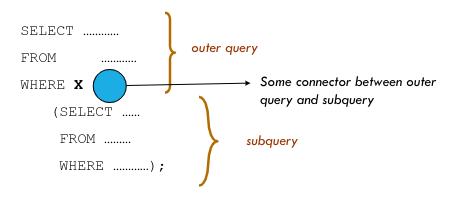7.8 KiB
7.8 KiB
title:: SQL SELECT: Working with Strings & Subqueries
- #CT230 - Database Systems I
- Previous Topic: SQL DML: SELECT
- Next Topic: Aggregate Clauses, Group By, & Having Clauses
- Relevant Slides:
-
Keywords to Modify Output
AS#card card-last-interval:: -1 card-repeats:: 1 card-ease-factor:: 2.7 card-next-schedule:: 2022-11-15T00:00:00.000Z card-last-reviewed:: 2022-11-14T16:35:37.700Z card-last-score:: 1- Used to rename any output in
SELECT. - Can also be used to alias (rename) tables in
FROM.
- Used to rename any output in
CONCAT#card card-last-interval:: 11.2 card-repeats:: 3 card-ease-factor:: 2.8 card-next-schedule:: 2022-11-25T20:35:14.265Z card-last-reviewed:: 2022-11-14T16:35:14.265Z card-last-score:: 5- Used to concatenate strings.
- Similar usage to other programming languages.
-
SELECT CONCAT(fname, ' ', minit, ' ', lname) AS Name FROM employee WHERE salary BETWEEN 50000 AND 80000 ORDER BY lname;
CAST#card card-last-interval:: 33.64 card-repeats:: 4 card-ease-factor:: 2.9 card-next-schedule:: 2022-12-18T11:21:08.757Z card-last-reviewed:: 2022-11-14T20:21:08.757Z card-last-score:: 5CAST(<expression> AS <datatype>(<length>))- Used to cast to another datatype.
ORDER BY#card card-last-interval:: 11.2 card-repeats:: 3 card-ease-factor:: 2.8 card-next-schedule:: 2022-11-25T20:37:08.438Z card-last-reviewed:: 2022-11-14T16:37:08.438Z card-last-score:: 5ORDER BY <attribute list> <order (ASC or DESC)>.- Allows the results of a query to be ordered by values of one or more attributes.
- Either ascending
ASCor descendingDESC- ascending by default. - Must be the last clause of a
SELECTstatement.
-
card-last-interval:: 10.97 card-repeats:: 3 card-ease-factor:: 2.56 card-next-schedule:: 2022-11-25T15:38:08.480Z card-last-reviewed:: 2022-11-14T16:38:08.481Z card-last-score:: 5TOP&LIMIT#card- The
SELECT TOP <N>clause is used to specify the number of tuples (N) to return, but it is not supported by MySQL. - Instead, MySQL supports a
LIMIT <N>clause which has the same functionality. - The
LIMITclause is listed at the end of the query, - Example: List the employees with the top 3 salaries.
-
SELECT ssn, CONCAT(fname, ' ', lname) as Name, salary FROM employee ORDER BY salary DESC LIMIT 4;
-
- The
-
Strings
-
Note: 'Single' & "Double" Quotes #card
card-last-interval:: 23.43 card-repeats:: 4 card-ease-factor:: 2.42 card-next-schedule:: 2022-12-08T06:20:40.093Z card-last-reviewed:: 2022-11-14T20:20:40.094Z card-last-score:: 5- MySQL usually allows single & double quotes to be used interchangably.
- Generally, single quotes should be used for strings (
varchar(),text, etc.). -
How to Deal with Apostrophes in Strings #card
card-last-interval:: 33.64 card-repeats:: 4 card-ease-factor:: 2.9 card-next-schedule:: 2022-12-18T11:21:10.692Z card-last-reviewed:: 2022-11-14T20:21:10.692Z card-last-score:: 5- You have to be careful with apostrophes in strings, as an opening quote could be accidentally closed by an apostrophe.
- To overcome this, if there is an apostrophe in a string, it should be replaced by two apostrophes side-by-side
''(this is a general rule for all special characters - have two of the character) or escape it with\. - Example: Select the salary for the employee with surname O'Grady.
-
SELECT salary FROM employee WHERE lname = 'O''Grady';
-
- We must also take care when inserting string data using
INSERT INTO.
-
Working with Strings & Pattern Matching #card
card-last-interval:: 4.14 card-repeats:: 2 card-ease-factor:: 2.56 card-next-schedule:: 2022-11-22T21:33:52.858Z card-last-reviewed:: 2022-11-18T18:33:52.859Z card-last-score:: 5- SQL is case insensitive (apart from table names if on a Linux server).
- Case insensitivity generally applies to string searching.
- However, often when working with strings we do not look for an exact match (i.e., an exact match using
=). - To support partial matching, we often use pattern-matching characters and
LIKEwith wildcard characters%and_.%represents 0 or more characters._Represents a single character.
-
Regexp
- We can use regex for more complicated string matching.
-
SELECT <attribute> FROM <relation> WHERE <attribute> REGEXP <regexp> ^Matches position at the beginning of the searched string.$Matches position at the end of the searched string.[]Matches any character inside the square brackets.[^]Matches any character not inside the square brackets.*Matches preceeding character 0 or more times.+Matches preceeding character 1 or more times.|OR.{n}Matches preceeding character n number of times.
-
-
Accessing Data Across Multiple Tables
card-last-score:: 5 card-repeats:: 2 card-next-schedule:: 2022-10-11T03:36:21.816Z card-last-interval:: 3.71 card-ease-factor:: 2.46 card-last-reviewed:: 2022-10-07T10:36:21.817Z- What methods can you use for accessing data across multiple tables? #card
card-last-interval:: 4
card-repeats:: 2
card-ease-factor:: 2.7
card-next-schedule:: 2022-11-18T20:10:10.085Z
card-last-reviewed:: 2022-11-14T20:10:10.085Z
card-last-score:: 5
- There are 3 potential approaches:
- Joins.
- Subqueries.
- Union queries.
- There are 3 potential approaches:
-
Subqueries #card
card-last-interval:: 11.2 card-repeats:: 3 card-ease-factor:: 2.8 card-next-schedule:: 2022-11-25T20:36:08.786Z card-last-reviewed:: 2022-11-14T16:36:08.786Z card-last-score:: 5- A subquery (also called a nested query)is a query with another query.
- The subquery usually returns data that will be used in the main query.
- Data returned from the subquery may be a set of values or a single value.
- Subqueries can be used with the
SELECT,INSERT,UPDATE, andDELETEstatements. 
- The
SELECTstatement that contains a subquery is called an outer query. -
Connecting Inner & Outer Queries #card
card-last-interval:: -1 card-repeats:: 1 card-ease-factor:: 2.08 card-next-schedule:: 2022-11-15T00:00:00.000Z card-last-reviewed:: 2022-11-14T20:19:14.578Z card-last-score:: 1- If a subquery returns only one value then we can use operators such as
=,!=.>,>=,<,<=. - If a subquery could return more than one value (i.e., a list of values), then we need connectors such as
IN,ANY,ALLto check through the values of the subquery.- The keyword
NOTcan also be used where appropriate. - These connectors are generally used with basic algebraic operators:
=,!=.>,>=,<,<=. ALL- the condition is true if the comparison is true for every (all) values returned by the subquery.ANY- the condition is true if the comparison is true for at least one (any) value returned by the subquery.IN- the condition is true if the comparison is true for at least one value returned by the subquery, i.e., a value IN the subquery.INchecks for equality - it can be used for a list of values or a single value - it does not require any additional algebraic operator.
- The keyword
- In addition, we can have a more general condition using:
EXISTS- True if there exists at least one value in the result from a subquery.NOT EXISTS- True if there is nothing in the result from a subquery (i.e., it is empty).
- If a subquery returns only one value then we can use operators such as
- What methods can you use for accessing data across multiple tables? #card
card-last-interval:: 4
card-repeats:: 2
card-ease-factor:: 2.7
card-next-schedule:: 2022-11-18T20:10:10.085Z
card-last-reviewed:: 2022-11-14T20:10:10.085Z
card-last-score:: 5
